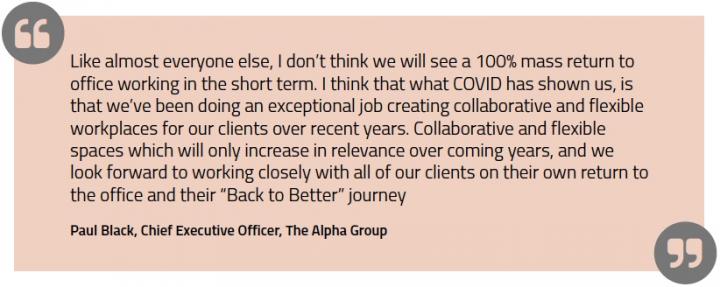
- Written by the team at 1080
We must also be able to proactively manage the space that our clients have, making it a welcoming, collaborative and safer environment for employees and visitors alike.
Some aspects of the workplace environment as we know it may have changed forever. In this regard, and in order to support a transition back to the workplace, the Ten Eighty team within the Alpha Group will be creating tailored and bespoke destinations for all of our employees. Destinations that will be vibrant and engaging whilst recognising the precautions and social distancing guidelines to which we have all become so accustomed over the last 12 months.
As part of the Global response to the pandemic, Steelcase, a long standing Partner of 1080 and the Alpha Group, have provided valuable insights into the evolving office and workplace environments.
“The pandemic has reshaped many aspects of our lives, including where and how people want to work,” said Gale Moutrey, vice president of workplace innovation at Steelcase. “Their experiences working from home, and what they face when they return to the office, have influenced what they want and expect to see in the workplace going forward. The majority of workers will return to the office and their work from home experiences will provide the guidance for a new, better work experience.”
Whilst it is perhaps unreasonable to assume that we will see a 100% mass return to the workplace during 2021, businesses do need to take this opportunity in advance to be proactive about understanding employees’ concerns, embracing new modes of working and reflecting many of the positive experiences that staff have enjoyed over recent months.
In global research, incorporating 32,000 participants across 10 countries, Workplace experts at the world’s largest office furniture manufacturer, Steelcase identified a number of key factors that employees will need and moreover will expect from a post COVID working environment.
however, at a time when there is an increasing focus on mental health awareness:
With these key findings in mind, organisations will need to design workplaces that are compelling enough to encourage workers to commute, however with some element of hybrid working likely to continue we will also need to improve standards for home working as well as office spaces.

Synthesizing these studies uncovered five overarching employee needs in the overall work experience and lead to new ways of planning and designing offices.
To be safe and feel safe: people will make decisions about where to work based on a new set of safety standards to help prevent transmission in the office.
A deeper sense of belonging: people’s top reason to return to the office is to connect with co-workers. People want to feel a sense of belonging at work, which is not only good for their wellbeing but it also helps business results — feeling a strong sense of community is the top indicator of people’s productivity, engagement, innovation and commitment to the organization.
To be productive: people’s desire to accomplish something meaningful, has only heightened during the crisis. While some experienced “panic productivity” in the early pandemic days, most simply want to be of value and feel their work has purpose.
Holistic comfort: during the past year many people had to improvise and work from sofas, kitchen tables and even beds. Pain, distractions and stress have caused people to yearn for a broad interpretation of comfort. They need the ability to work in a range of postures, change settings and to move throughout their day.
Greater control: people want to choose where to work or to adapt spaces based on the task they’re doing. While some people feel working from home has allowed them to navigate their day and avoid distractions, nine of 10 countries rank a “quiet, professional environment” in their top five reasons for wanting to return to the workplace. Teams also need control over the level of privacy and the flexibility to move things around to best suit their work.

A new set of design principles that will enable organisations create a better work experience, delivering on what people need now and in the future.
Me + we: equally support individual and teamwork. While some believe the primary reason, people want to work in the office is for group activities, people say they also want the ability to focus and work in a professional environment. Relying on home offices to support individual work isn’t viable for an inclusive organization, because various factors — such as limited home space, distractions or commute time — make it challenging for people to always do individual work from home.
Fixed to fluid: design planning in the past often relied on a more formulaic approach, with a mindset toward permanent architecture and office settings. The new realities of how people and organizations need to become more agile requires designers to plan spaces that will regularly morph and change as needed.
Open + enclosed: more enclosed “me” and open “we” spaces. People, who often did individual work in more dense, open spaces, desire more enclosure or shielding to control privacy and safety. Teams, who frequently worked in enclosed conference rooms, prefer to be in more open settings, both for a sense of safety and the flexibility to expand and contract and adjust their space easily based on their activities.
Braiding digital + physical: remote collaboration is here to stay. Designers need to create solutions for individual and group video interactions that are not constrained to laptops or phones. Steelcase’s partnership with Microsoft, for example, provides solutions that enhance the human experience through technology. Sensing technologies will need to be embedded to support increasing data-driven or artificial intelligence-guided experiences.
This article first appeared in the Spring 2021 edition of the Sync NI magazine. You can download your FREE copy and sign up to recieve future digital editions here.